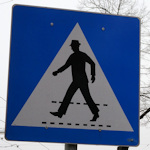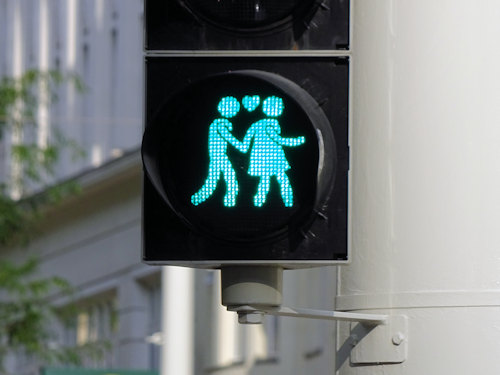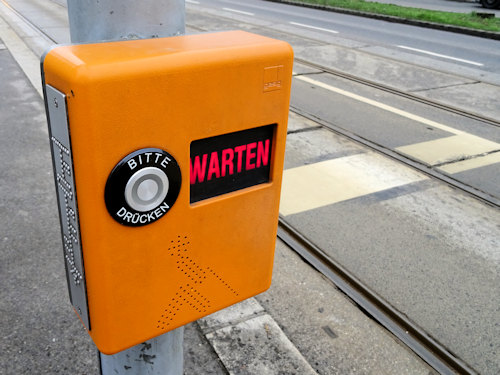
So you’re probably thinking, “Hey, this isn’t rocket science – I think I know how to cross a road”. And you’d probably be right.
But…there are some local habits that might make it more complicated than you were expecting.
- See also:
Black and white stripes across a road indicate a “Schutzweg” for pedestrians to cross safely (in theory). In fact, if there is such a zebra crossing within 25m of where you want to cross, then you’re obliged by law to use it.
There are two main types of crossings: unregulated and regulated.
Without stop/go lights

(A “Schutzweg” for pedestrians)
“Unregulated” crossings are marked with warning lights or a simple traffic sign like in the photo above.
This is where you need to be particularly careful.
The law obliges drivers to stop and allow pedestrians unhindered passage across the road if the pedestrian is on (or clearly waiting to use) the crossing .
But they don’t always stop.
Most do, if they see you waiting, but some don’t. A survey in Vienna back in 2021, for example, found 1 in 10 drivers did not do so.
This can be quite a shock to those used to, for example, UK driving habits.
So I’d advise always waiting to cross until the cars actually stop for you. Even then, keep an eye out: I’ve seen cars overtake those cars that stopped to let pedestrians cross.
The even safer option

(The couples lights found throughout the city, but mostly in the centre)
“Regulated” crossings use stop/go lights for pedestrians in combination with traffic lights for vehicles, so are even safer to use of course.
Take care though – at junctions, for example, a green pedestrian light doesn’t always mean all cars have a red light. Those turning onto the road you’re crossing may still have a green light, though they should normally wait for you to cross.
The sequence for the pedestrian lights is nothing unusual:
- Red person (don’t cross)
- Green person (um, cross)
- Flashing green person (lights are turning red imminently so don’t start crossing)
- Back to red person
If you’re lucky, you might find one of the “couples” pedestrian lights put up when Vienna hosted the Eurovision Song Contest (pictured above in one version; same-sex couples are also common motifs for these lights).
At most junctions, pedestrian lights tend to change automatically. However, you might need to press a button to activate the process. This is quite common at regulated pedestrian crossings located away from an actual junction.
The below photo shows an example of one such situation. Here, you need to press the button marked “bitte drücken”:

(Not every box needs pressing like this one. Some are only there to help vision-impaired people)
In this example, the word “warten” (“wait”) shows up and the lights will eventually change in your favour. If you don’t press the button, the lights may never change:

(Waiting times vary: one or two notorious crossings seem to take long enough for a change of government in the meantime)
Sometimes you find a Schutzweg at a junction with traffic lights, but without pedestrian lights or any other indications that it’s a Schutzweg, other than the black and white road markings.
That situation is a little more complicated.
You may cross when traffic perpendicular to the Schutzweg has a red light. But, again, traffic turning into this road may have a green light. So take extra care. They are obliged to stop for you, but only in theory and by law.
Equally, some road traffic lights cease functioning at night (they blink orange). Even so, the Schutzweg rules should apply. However, some drivers don’t realise this (or choose to ignore the rules). So be extra careful if crossing at such a junction.
Safe journey!